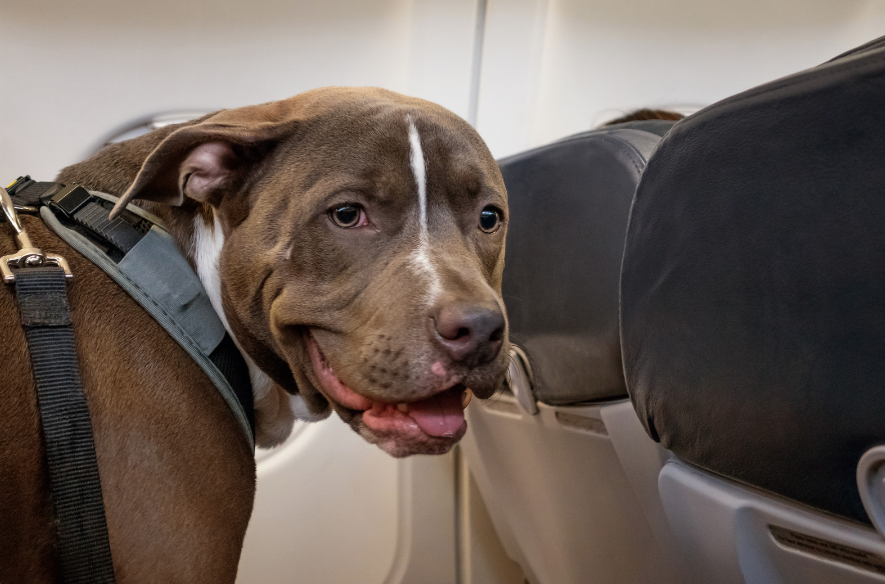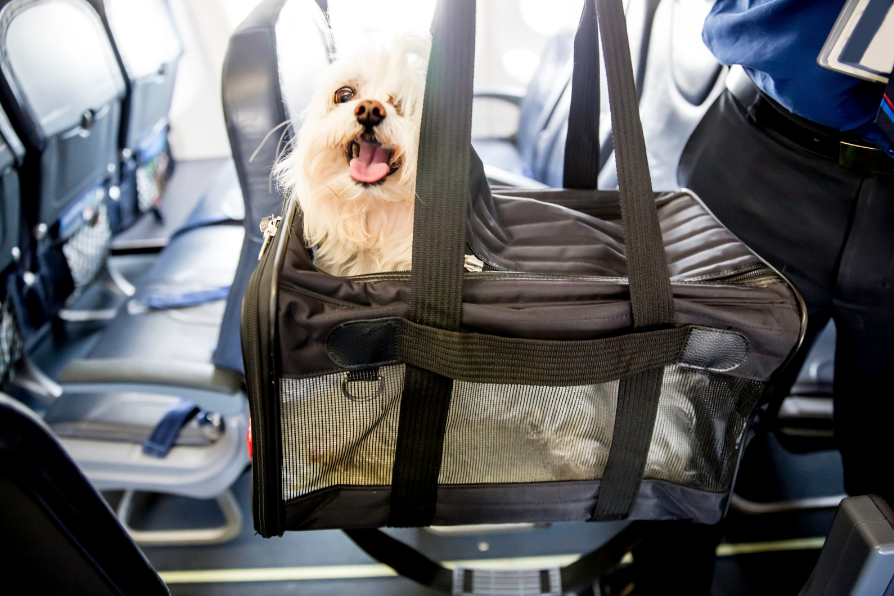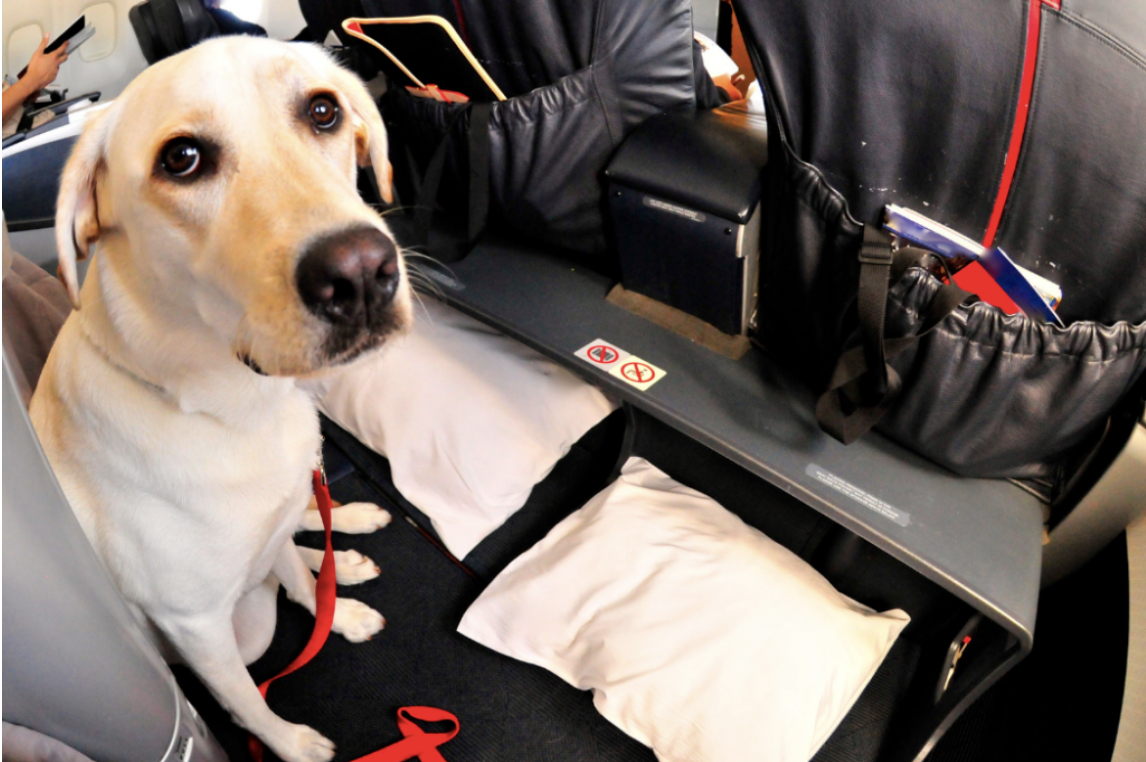Want to Buy Your Dog a Seat on an Airplane? Here’s Exactly How You Do It.

If you’re off to see the world, it’s only natural that you’d want to take your best friend with you. The question is, however, can you? Between legal and airline regulations, it can be difficult to get your dog on board, and you may need to jump through some hoops to do so, especially if your goal is flying with a dog in a cabin rather than in cargo.
However, once you know what to do, you shouldn’t have any problem taking your pup with you on all your adventures! Here’s everything you need to know about buying your dog a seat on an airplane!
Individual Airline Policies
Each airline holds different policies on flying with pets, so it’s best to do your own research to find an airline that will allow your dog to fly, since every airline sets their own weight-limit for dogs on planes. It’s also important to note what airlines allow dogs in-cabin, and that prices can vary significantly if you fly internationally vs. domestic. To provide some extra information, we’ve compiled pet policies, flight costs, and other basic information about a few popular US airlines.
| Airline | Pets Allowed? | Size of Pets | Prices |
| American Airlines | Yes | Depending on size, can be cargo or carry-on. | $125-$200 |
| Spirit Airlines | Domestic only | 40 pounds or less | $110 each way |
| Southwest Airlines | Domestic only | Small, carry-on size | $95 each way |
| Delta Airlines | Yes | Depending on size, can be cargo or carry-on. | $75-$200 |
| Jetblue Airways | Yes | Depending on size, carry-on, or extra seat. | $125 each way |
Airlines That Allow Big Dogs In-Cabin
Most commercial airlines are required set strict weight and size limits for pets flying in-cabin, but there are a handful of independent and smaller airlines that allow big dogs in cabin. Remember that if you are flying with a service dog, size restrictions do not apply, and you can fly with any commercial or private airline.
| Airline | Type | Dog Size Limits (in cabin) | Prices |
| JSX Airlines | Charter/Hop-on jets | Dogs under 79 lbs | Price of second seat |
| Surf Air | Dogs under 100 lbs | $50-$100 | |
| Tradewinds Aviation | Private charter | All dogs | Second seat required for dogs 100+ lbs |
Making Your Pet Comfortable
So, you’ve gotten your pup their airline ticket, but you aren’t sure how they’ll cope with the unfamiliar environment. Fortunately, there are a few tips for flying with a dog in-cabin you can use to ensure they’ll remain calm throughout the flight.
First of all, ensure their carrier is large enough for them to move around in. Your dog should be able to turn around and readjust themself comfortably. Second, ensure they go to the bathroom before the flight. For obvious reasons, your dog won’t be able to relieve themself during the flight, so by taking care of business beforehand, you can ensure your pup won’t be uncomfortable. By taking these extra steps, you can ensure your buddy will be happy from takeoff to landing!

Bringing a Service Dog on a Plane
Service dogs–which are individually trained either to perform a task or perform work for a specific personal with disabilities–are allowed to fly on all major airlines free of charge. People with disabilities have the right to bring their service dogs with them everywhere, and are not subject to the same rules as pet owners, emotional support dog owners, or therapy dog owners.
Service dogs recieve specific legal protections, and can only be denied by an airline if they pose a significant threat to the health or safety of those on board, or if their handler cannot present the proper paperwork or certification.
Although service dogs are always allowed on flights, you will still need to call ahead to notify the airline that you will be traveling with your service animal.
See also 8 Dog-Friendly Restaurants in Portland
FAQ
Here are a few of the most commonly asked questions about taking your dog on flights with you, so if there’s anything you’re still wondering, feel free to keep reading!
Want to Buy Your Dog a Seat on an Airplane? Here’s Exactly How You Do It.

If you’re off to see the world, it’s only natural that you’d want to take your best friend with you. The question is, however, can you? Between legal and airline regulations, it can be difficult to get your dog on board, and you may need to jump through some hoops to do so, especially if your goal is flying with a dog in a cabin rather than in cargo.
However, once you know what to do, you shouldn’t have any problem taking your pup with you on all your adventures! Here’s everything you need to know about buying your dog a seat on an airplane!
Individual Airline Policies
Each airline holds different policies on flying with pets, so it’s best to do your own research to find an airline that will allow your dog to fly, since every airline sets their own weight-limit for dogs on planes. It’s also important to note what airlines allow dogs in-cabin, and that prices can vary significantly if you fly internationally vs. domestic. To provide some extra information, we’ve compiled pet policies, flight costs, and other basic information about a few popular US airlines.
| Airline | Pets Allowed? | Size of Pets | Prices |
| American Airlines | Yes | Depending on size, can be cargo or carry-on. | $125-$200 |
| Spirit Airlines | Domestic only | 40 pounds or less | $110 each way |
| Southwest Airlines | Domestic only | Small, carry-on size | $95 each way |
| Delta Airlines | Yes | Depending on size, can be cargo or carry-on. | $75-$200 |
| Jetblue Airways | Yes | Depending on size, carry-on, or extra seat. | $125 each way |
Airlines That Allow Big Dogs In-Cabin
Most commercial airlines are required set strict weight and size limits for pets flying in-cabin, but there are a handful of independent and smaller airlines that allow big dogs in cabin. Remember that if you are flying with a service dog, size restrictions do not apply, and you can fly with any commercial or private airline.
| Airline | Type | Dog Size Limits (in cabin) | Prices |
| JSX Airlines | Charter/Hop-on jets | Dogs under 79 lbs | Price of second seat |
| Surf Air | | Dogs under 100 lbs | $50-$100 |
| Tradewinds Aviation | Private charter | All dogs | Second seat required for dogs 100+ lbs |
Making Your Pet Comfortable
So, you’ve gotten your pup their airline ticket, but you aren’t sure how they’ll cope with the unfamiliar environment. Fortunately, there are a few tips for flying with a dog in-cabin you can use to ensure they’ll remain calm throughout the flight.
First of all, ensure their carrier is large enough for them to move around in. Your dog should be able to turn around and readjust themself comfortably. Second, ensure they go to the bathroom before the flight. For obvious reasons, your dog won’t be able to relieve themself during the flight, so by taking care of business beforehand, you can ensure your pup won’t be uncomfortable. By taking these extra steps, you can ensure your buddy will be happy from takeoff to landing!

Bringing a Service Dog on a Plane
Service dogs–which are individually trained either to perform a task or perform work for a specific personal with disabilities–are allowed to fly on all major airlines free of charge. People with disabilities have the right to bring their service dogs with them everywhere, and are not subject to the same rules as pet owners, emotional support dog owners, or therapy dog owners.
Service dogs recieve specific legal protections, and can only be denied by an airline if they pose a significant threat to the health or safety of those on board, or if their handler cannot present the proper paperwork or certification.
Although service dogs are always allowed on flights, you will still need to call ahead to notify the airline that you will be traveling with your service animal.
See also 8 Dog-Friendly Restaurants in Portland
FAQ
Here are a few of the most commonly asked questions about taking your dog on flights with you, so if there’s anything you’re still wondering, feel free to keep reading!
Which Airlines Will Allow Me To Buy A Seat For My Dog?
There are a large number of pet-friendly airports scattered around the nation, with some of the most notable being JFK Airport, DFW Airport, and Los Angeles Airport. However, these are by no means the only airports you can take your pup to, so just check out your local airport’s rules and regulations!
Can Dogs Fly in First Class?
As usual, it varies from airline to airline, but as a general rule, no, most airlines don’t allow this. However, there are a few exceptions to this rule, such as United Airlines.
Can You Fly Business Class with a Dog?
While it can, of course, vary from airline to airline, most airlines do allow dogs to fly with their owners in business class.
Can I Buy A Seat For My Dog On An Airplane Internationally?
Assuming the airline you’re using allows pets, yes, you’ll be able to buy international plane tickets for your dog. However, you need to be prepared to pay a little (or a lot) extra. Many airlines require additional fees for international tickets for your pets, and this can range anywhere from a few hundred dollars to a few thousand. As long as you can afford that, though, it shouldn’t be a problem!
Can I Buy A Plane Ticket For My Large Dog?
If you’re flying with a pet-friendly airline, you’ll typically be allowed to purchase an extra seat for your large dog, but you may have to pay an extra pet fee depending on the airline.
Can I Buy A Seat For My Dog On An Airplane 2023?
That depends on the airport, but as long as you do your research beforehand, yes, you should be able to! Before buying your own tickets, look at what your local airline says about tickets for your pets.
Can My Dog Sit On My Lap During A Flight?
Typically, no. If your dog is over 25 pounds, you’ll have to buy a separate seat, but if they’re 25 pounds or under, you can take them with you as a carry-on for a small pet fee. The caveat to this, however, is that they have to stay in a pet carrier for the duration of the flight, and the carrier has to rest in front of or under the seat.
How Big Of A Dog Can Fit Under An Airplane Seat?
Dogs under 25 pounds can be placed under an airplane seat without the need to buy a separate ticket. However, you may need to pay an additional pet fee.
What’s The Best Seat On A Plane With A Pet?
Try to purchase seats with plenty of space available. This will prevent both you and your pup from feeling cramped and uncomfortable during the flight.
What is the Cheapest Way to Travel With a Dog?
The cheapest way to travel with your dog depends entirely on where you are going. If you are traveling just a state away, driving might be the most affordable option, whereas flying might be more affordable if you are doing a long-distance move.
Can Brachycephalic Dogs Fly on Planes?
Most airlines ban brachycephalic breeds (like Pugs and French Bulldogs) due to their particular anatomical vulnerability to changes in air and atmospheric conditions. Flat-faced breeds are predisposed to breathing issues, and flying may pose a risk to their general health. Because of this, it’s best not to fly with a flat-faced dog.
See also I Opened A Restaurant for Homeless Dogs
Related Posts
- Dog Friendly Restaurants
- 18 Dog Friendly Restaurants in San Diego
- Dog-Friendly Restaurants in Boston
- Top 12 Dog-Friendly Restaurants in Chicago



